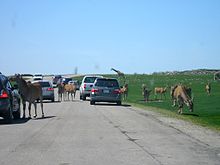African Lion Safari
 |
|

Visitors in the reserves
|
|
| Date opened | August 22, 1969 |
|---|---|
| Location | Hamilton, Ontario, Canada |
| Coordinates | 43°20′28″N 80°10′48″W / 43.341°N 80.180°WCoordinates: 43°20′28″N 80°10′48″W / 43.341°N 80.180°W |
| Land area | 300 hectares (740 acres) |
| No. of animals | >1,000 |
| No. of species | >100 |
| Memberships | CAZA,WAZA, IEF, and IAATE |
| Website | www |
African Lion Safari is a family-owned safari park situated in Hamilton, Ontario, Canada, about 100 kilometres (62 mi) west of Toronto. Though situated in Hamilton city limits, it is located near Cambridge, Ontario. It includes more than 1,000 animals, representing over 100 species of mammals and birds from across the globe. Guests may tour seven game reserves (with a total area of about 740 acres (300 hectares)) traversed via tour buses or the visitors' own vehicles where animals roam freely in large contained areas. Accompanying the game reserves is a large walking section where hundreds of exotic birds and primates, as well as the park's herd of Asian elephants, are on display.
It is an accredited member of the CAZA, and is also a member of the World Association of Zoos and Aquariums (WAZA), the International Elephant Foundation (IEF) as well as the International Association of Avian Trainers and Educators (IAATE).
It is open from the first weekend in May to the weekend of Canadian Thanksgiving in October and has an on-site bus in which to tour the park, but public transportation to the park itself is limited.
This safari park was founded by Gordon Debenham "Don" Dailley, a retired Canadian Army colonel, and opened its doors on August 22, 1969. Dailley initially partnered with the Chipperfield family from England to purchase four farms in the Rockton, Ontario area totaling 250 hectares (620 acres). He bought out the Chipperfields in the early 1970s. Dailley's sons Don and James, along with their sister Ginny, took over operations in 1989, following their father's death. It remains privately owned, and the only significant feature was the drive-through reserve. In 1971, the park began working with Asian elephants, and in 1985 they started to make a concentrated effort to breed Asian elephants. Over the years, successful breeding of 30 endangered species and 20 threatened species has occurred in the park.
...
Wikipedia
